Air ducts are transport networks of the ventilation system. Their design and installation are governed by strict regulations and process flow charts. Compliance with regulatory requirements during construction is a guarantee of flawless operation of the network, ensuring stable air exchange.
We will show you how to install ventilation pipes in accordance with building requirements. Every developer is obliged to know the basic rules for laying and fixing air ducts. Owners can also use the information to understand the cause of the problem and decide how to fix it.
The content of the article:
- Duct design and requirements
- Connection options for assembling ventilation ducts
-
Fastening ventilation pipes to the wall and ceiling
- Features of installing rigid ventilation ducts
- Fasteners for rigid ducts
- Fixation of flexible ventilation ducts
-
The procedure and methods for installing air ducts
- Installation of horizontal ducts inside the building
- Assembly of vertical ducts using the "build-up from below" method
- Installation of vertical ducts "build-up from above"
- Installation of vertical air ducts "extrusion"
- Flexible air duct
- Work safety
- Conclusions and useful video on the topic
Duct design and requirements
The movement of air flows inside and outside the building is carried out along vertical and horizontal ventilation ducts. Installation of ventilation pipes is carried out according to the design marks indicated in the working drawings. Installation rules are given in the normative collections of SP 73.13330.2016 and SP 60.13330.2016.
Ventilation ducts can be laid inside the main walls or located in the premises of the house under the ceiling or along the walls. Often circumstances dictate the design of air ducts outside the building.

It happens that the laying of air ducts is done outside the building. The prerequisites for such a solution are mainly associated with the conversion of residential buildings into commercial or industrial
Separation of channels by functionality:
- supply air - through them fresh air enters the house;
- exhaust - to remove contaminated air masses.
With natural ventilation in a private house, all exhaust ducts can pass in one shaft. For this room with high humidity, unstable temperature and characteristic steam generation, from which the used air is removed, the designers try to arrange next to each other.
There are a number of requirements for ventilation ducts:
- tightness;
- noiselessness;
- compactness, location in hidden parts of the house;
- strength, durability.
During installation, the spatial structure of the ducts is created from individual standard parts. For its construction, in addition to rectilinear elements, additional fittings are used.
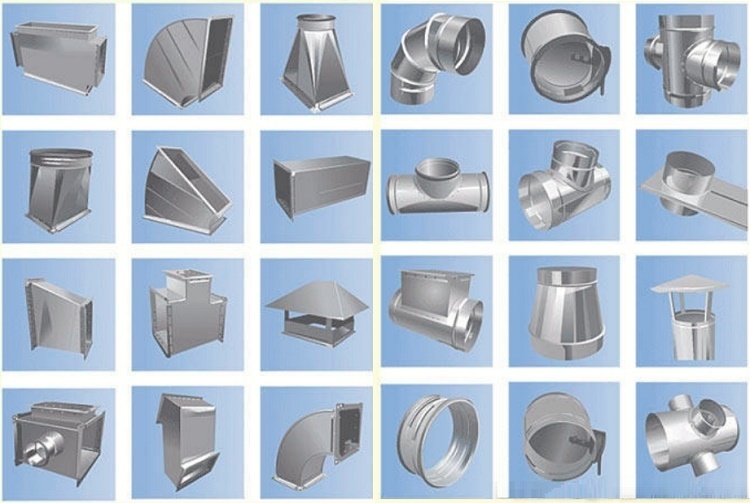
The bend is used to rotate the channel by 90 degrees. The tee and the cross are designed to create branches from the mains. Umbrellas prevent debris and precipitation from entering the pipe. The nipple connects all parts together
According to the external configuration, round and rectangular air ducts are used. Tubes with cylindrical shapes have optimal data for the smooth movement of air masses. Rectangular boxes allow you to save free space, they are easy to hide behind false walls and false ceilings.
Air ducts are rigid and flexible. Rigid lines are made in round and rectangular versions according to VSN 353-86, TU-36-736-93.
For the hard option, materials are used:
- cold rolled galvanized steel - 0.5 - 1.0 mm;
- hot rolled sheet steel - 0.5 - 1.0 mm;
- polymers - 1.0 - 1.5 mm.
Suitable for damp rooms plastic air ducts or stainless steel with a thickness of 1.5 - 2.0 mm. In chemically active zones, pipes made of metal-plastic, aluminum and its alloys are used.
Flexible channels are made in the form of pipes made of soft material. They are often used as convenient inserts for connecting rigid ducts to ventilation equipment.
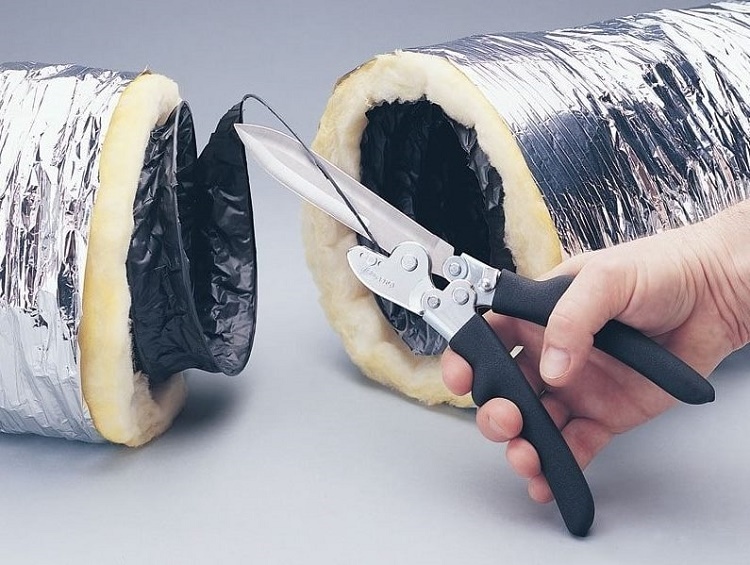
The cross-section clearly shows the multilayer structure of a flexible insulated channel: a soft shell, a reinforcing plastic or metal frame. Obedience to pipes is given by materials: aluminum foil, polyester, silicone, textiles, rubber
Curved ventilation ducts are suitable for moving air at low speed and pressure.
In residential buildings, they often install PVC ventilation pipes with high heat and sound insulation properties.
Typical parts made of polyvinyl chloride are connected using:
- one-piece contacts - butt welding or welded sleeves;
- detachable elements - flanges, couplings, sockets.
Fasteners to PVC air ducts are used both suspended and supporting.
Thermal insulation protects the ventilation ducts from condensation. This mainly applies to industrial and unheated premises. For private houses and offices, thermal insulation is used when insulation of ventilation in the attic. Soundproofing of pipes is carried out in living rooms.
It is imperative that the metal ventilation pipes are grounded to relieve the build-up of static electricity.
Connection options for assembling ventilation ducts
Air ducts are assembled from individual parts. Docking is carried out using flanges or other connecting elements.
Angle flanges are installed at the ends of the sections to be joined. Holes are drilled on them for fastening bolts. Sealing gaskets are placed between the flanges.
The bolts are carefully tightened with nuts and a suitable wrench to ensure the flange connections are strong. The nuts are on one side of the connection. When installing vertical pipes, the nuts are located on the side of the bottom flange.
The disadvantages of such a connection lie in a significant weighting of the structure, high consumption of metal, and high labor intensity of work.
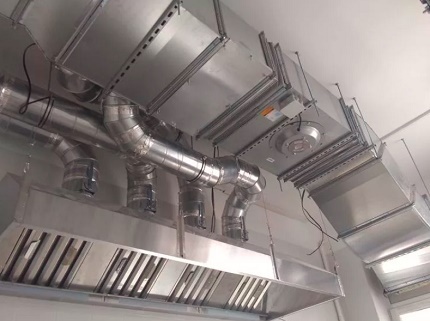
A sealing tape is placed between the flanges of the parts to be connected. Its edges should not protrude into the interior of the pipe and cover the bolt holes. For the manufacture of an oil seal, dense or porous rubber, foam rubber is used
Lighter flanges are made of profile galvanized strip. The Z-shaped flanges are connected with a C-shaped strip and a seal.
The connecting bar resembles a collapsible flange. It is made of a galvanized metal profile in the shape of the letter G. The length of the larger side is from 20 to 30 mm. The kit includes a seal and a corner. The advantages include low labor intensity and low financial costs.
Among the wafer joints used to assemble round air ducts, the most commonly used are:
- nipple;
- bandage.
The nipple thickness must not be less than the pipe thickness.
The nipple is inserted inside or put on over the abutting elements in such a way that its width covers both sides of equal length for the pipe diameters:
- 100 - 315 mm - not less than 50 mm;
- 355 - 800 mm - not less than 80 mm;
- 900 - 1250 mm - not less than 1000 mm.
Instead of nipple, the term coupling is often used.
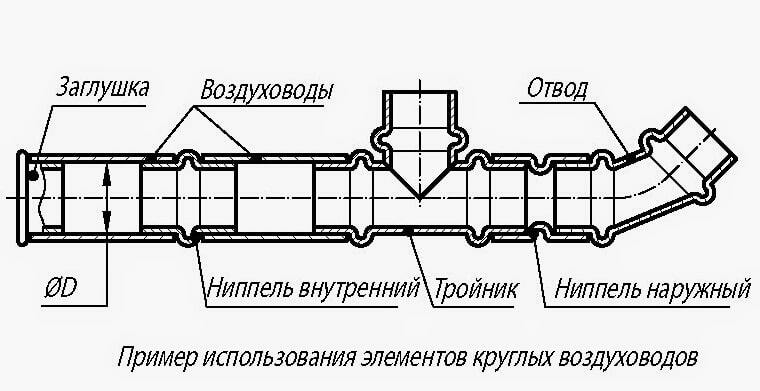
The tightness of the nipple connection is ensured by a rubber gasket included in the delivery set. In its absence, the fastening is sealed with adhesive tape with a polymer or reinforced coating. Every 200 mm of the circumference, the coupling is tightened with rivets or self-tapping screws with a diameter of 4-5 mm. The number of bindings must not be less than three
The bandage connection is considered to be of a high degree of strength and reliability. The edges of the straight and shaped parts of the air ducts are folded back and aligned. Then a bandage filled with sealant is applied to the pipes at the seam and tightened.
When connecting the air ducts, the seams are sealed:
- elastoplastic tapes like "Guerlain" at temperatures up to 40 degrees;
- non-hardening mastic based on synthetic rubber (for example "Buteprol"), silicone and other seals that can withstand heating up to 70O WITH.
The seam of the pipe or box is located on top.
When moving an air mixture with a temperature above 70O C as a sealant used elastic bundles of polyisobutylene, bitumen mastic (PMZh) and other fire-resistant non-combustible materials.
Before joining the elements of the channel with thermal insulation, carefully fold the insulation from both ends. The sections are hermetically connected and the insulating layer is put back in place. The seam in the insulation is sealed with aluminum tape or clamps.
Fastening ventilation pipes to the wall and ceiling
Metal air ducts without insulation with band joints are attached to ceilings and walls by means of various structures: supports, brackets, hangers, clamps.
Features of installing rigid ventilation ducts
The distances between the fasteners are strictly standardized:
- for round pipelines with a diameter of less than 400 mm - no more than 4 meters;
- for diameters equal to or greater than 400 mm - no more than 3 meters;
- for boxes with a side section of less than 400 mm - no more than 4 meters;
- with a cross-sectional side equal to or greater than 400mm - no more than 3 meters.
To remove the resulting condensate, the horizontal sections of the air ducts are laid with a slope of 0.01 - 0.015. Water droplets roll down an inclined surface into drainage receptacles.
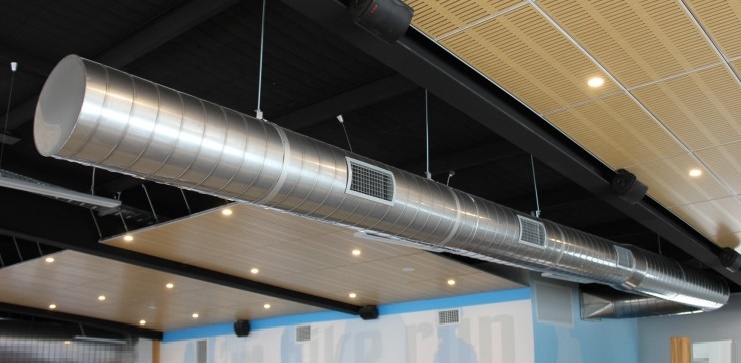
The axis of the horizontal ventilation pipe is located parallel to the surfaces of walls and ceilings, deviations are permissible when moving from one level to another
Laying of a ventilation pipe with a diameter of up to 630 mm with a flange and socket (nipple) docking in a horizontal position is carried out using various fasteners. The distance between them does not exceed 6 meters.
In other versions - no more than 4 meters. At the points of tie-ins or turns, the stability of the air duct is enhanced by additional supports.
Suspensions and supports of horizontal sections of rectangular metal boxes with a perimeter of up to 1600 mm with flange or busbar connections are placed at a distance of no more than 6 m from each other. For other connections, no more than 3 m, while the insertion points and cornering angles are also additionally strengthened.
Installation step of fasteners for metal air ducts of any cross-sections and dimensions with insulation, as well as for pipes without insulation with a diameter of more than 2000 mm or boxes with a side of more than 2000 mm is indicated in the working drawings.
Fasteners for vertical ventilation pipes carried out every 4.5 m. In multi-storey buildings with a floor height of up to 4.5 m, air ducts are fixed in the floor ceilings. If the height of the premises is more than 4.5 m from floor to ceiling, the ventilation pipes are fastened to the walls in accordance with the instructions of the project documentation.
Vertical deflection of ventilation pipes is allowed within 2 mm per 1 meter of duct length.
An even distribution of tension over the suspensions is achieved by adjusting their length. Do not attach braces to the connection flanges. The fastening clamps should not dangle freely on the duct, but should fit snugly against its circumference or perimeter.
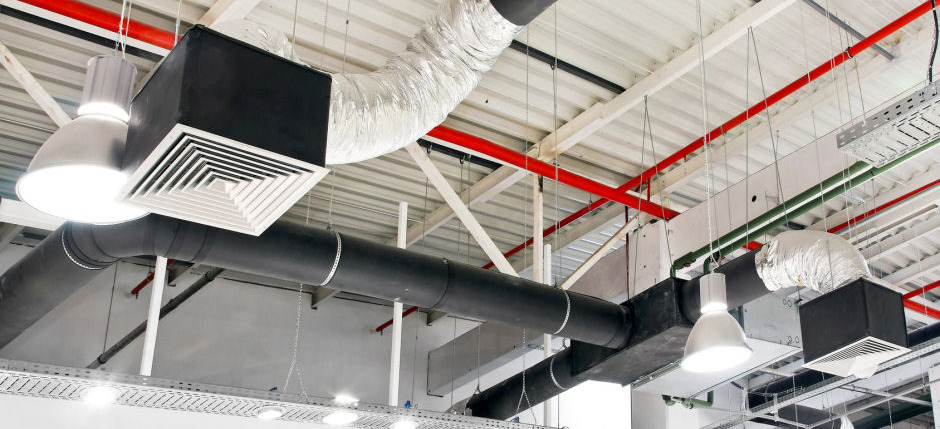
Double hangers for fastening the ventilation duct are made every two single ones, with the length of both in range from 0.5 to 1.5 m. For longer lengths, double hangers support the structure through each single suspension
All non-standard fasteners are calculated and displayed in the working drawings.
The distance from the plane of the house wall to the outer surface of the round ventilation duct is at least 50 mm, from the ceiling surface - 100 mm.
For rectangular ducts, this parameter depends on the dimensions of the sides of the duct section:
- on the side 100 - 400 mm - 100 mm;
- 400 - 800 mm - 200 mm;
- 800 - 1500mm - 400mm.
The minimum distance to water, gas and heat supply networks is 250 mm. To power supply lines at least 300 mm. The smallest distance between two round air ducts is 250 mm.
When passing through walls and ceilings, flange and other types of air duct connections are placed at a distance of at least 100 mm from their surface. Fasteners are installed no closer than 200 mm from the place of detachable connection.
Fasteners for rigid ducts
Below it will be described: with what devices and how to fix the ventilation pipe to the ceiling.
Fasteners used for this purpose include:
- A stud and a Z or L shaped profile provide additional support for the duct from below. The method is suitable for the installation of heavy structures. The connection is fixed with self-tapping screws and a rubber gasket between the stud and the profile.
- The stud clamp is the best choice for duct ducts.
- Traverse with two pins is suitable for main ventilation ducts with a side of a rectangular cross-section over 600 mm. The air duct is laid on a traverse, which can be metal plates and profiles.
- Clamp without stud - used for short sections of flexible air ducts.
- Perforated tape - fastening for light pipes and rectangular ducts with a diameter and side up to 200 mm. To cover a round surface, a loop is made from the tape, in the boxes the punched tape is fixed to bolted connections.
Opposite ends of the above fixing devices are connected directly to the ceiling rooms in the form of an anchorage element or attached to metal beams with bolts or clamps.
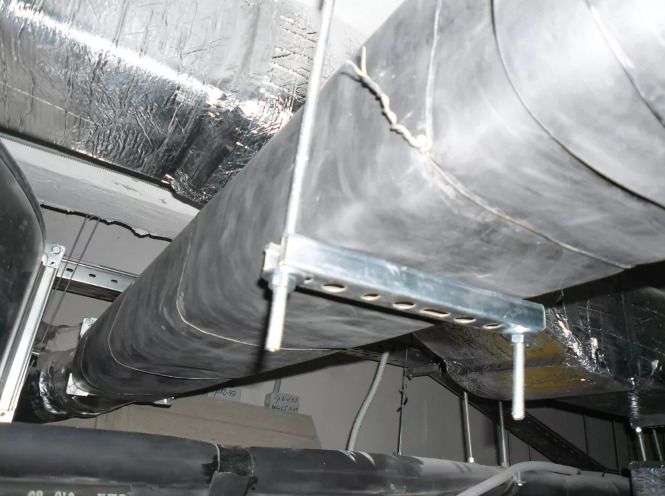
Shift of the box to the sides on the traverse is limited by side studs. The displacement of the ventilation duct along the axis is hindered by a rubber seal between the surface of the traverse and the edge of the box. This option is well suited for air ducts with heat and sound insulation.
Fastening of ventilation pipes to the wall is carried out by means of embedded parts and cantilever structures.
For the production of fixation use:
- Brackets. They are embedded in the walls of buildings or are aimed at them with dowels from the PC-52-1 assembly gun. Horizontal air ducts are laid on angle steel brackets.
- Traction. Serve for hanging air ducts to building structures. Adjustable hangers control the tension of the ventilation duct braces. Standard 1 fixing per 2 meters of duct length.
- Clamps. Designed for fixing pipe air ducts on rods, grips, hooks. The width of the steel band of the clamp with a ventilation duct diameter of up to 400 mm is 25 mm, with a diameter of 450 - 1600 mm - 30 mm. Fixed with anchor bolts or dowels.
In one ventilation system, different types of fasteners are used. How to properly fix the ventilation pipe to the wall is shown in the photo below.

The length and depth of embedding the bracket into the wall depends on the dimensions of the ventilation pipe or duct. The minimum bracket size of 250 mm corresponds to an embedment at 150 mm depth, maximum 1500 mm - 380 mm
Since an extremely light-weight medium is transported along the air ducts, there are no special requirements for the strength of the brackets fastening. The main thing is that they can hold the weight of the highway itself.
Fixation of flexible ventilation ducts
To connect the air ducts to the fans, inserts made of vibration-insulating soft materials are used, which provide flexibility, tightness and durability of the connection.
Air ducts made of polymer film in straight sections can have bends of no more than 15 degrees. Metal inserts help them overcome the passage through building structures.
Flexible pipes are placed on rings of wire with a diameter of 3-4 mm at intervals of 2 meters. The diameter of the duct is 10% smaller than the diameter of the fastening ring.
Along the pipe axis, a load-bearing cable made of metal wire with a diameter of 3-4 mm is stretched, which is attached to the structures of the house every 20-30 meters. The steel rings are hung on the cable using wire or cut-out steel plates.
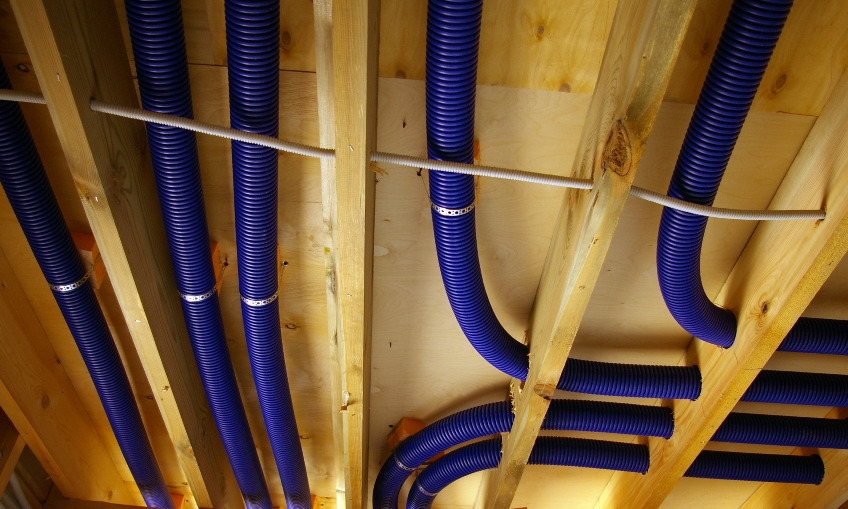
Sagging of flexible air ducts between the fastening rings is not allowed; to exclude them, the polymer film is pulled between the fasteners
Flexible pipes are used to connect:
- rigid ducts to ventilation equipment;
- complex fittings;
- mufflers and other devices.
For main ventilation pipelines flexible corrugated pipes use is prohibited. Soft air ducts cannot be used in vertical ducts longer than 2 floors.
The procedure and methods for installing air ducts
Before starting the installation of the ventilation system, a project for the production of works is developed. In it, the individual stages of the assembly of large units are outlined. Depending on the dimensions of the structures, their masses, the installation methods and the sequence of steps are chosen. They make a marking of the fasteners and check their completeness. In the graphic part of the PPR, the parking places of the lifting mechanisms are marked: winches, blocks, etc.
In the basement and basement floors, only rigid ventilation lines are installed.
To pass through walls and partitions, special inserts and metal cartridges are used.
In order to minimize speed losses, the turning angles of the route are rounded with a circle radius of at least 2 duct diameters.
For separate hidden sections of the ventilation piping (in mines, under the ceilings), acceptance certificates are drawn up for installation of air ducts, where the main characteristics and bindings of the mounted structures are recorded. A sample of drawing up a document is given in Appendix B of the set of rules of SP 73.13330.2016.
According to Appendix A of the same SP, the dimensions of the holes in the walls and ceilings of the building for laying ventilation ducts should be 150 mm wider of the corresponding diameter or side of the air duct.
Installation of horizontal ducts inside the building
Ventilation pipes are laid in accordance with the TTK regulations, section 07.33.01.
Work order:
- checking the availability of all the necessary parts and fasteners;
- marking of fastening means;
- embedding of anchors into the floor slab or support beams in the form of corners, channels;
- assembly of individual parts into enlarged units;
- installation of a lifting mechanism;
- slinging of the first knot;
- fastening the stretch marks at both ends of the knot;
- trial suspension to clarify the center of gravity of the structure;
- lifting to the design location and securing with hangers;
- control of placement accuracy and block unbundling;
- relocation of the winch for the installation of the next unit.
At the last stage, the accuracy of the block placement is checked, the slings are removed and the winch is rearranged for the installation of the next node.
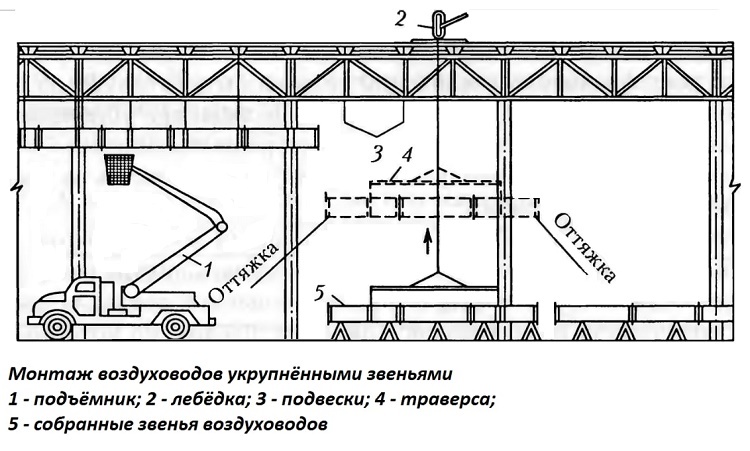
The use of traverses during the installation of enlarged ventilation blocks helps to maintain the horizontal structure of the structures, to avoid deflections and breaks. Air ducts are allowed to be attached to roof trusses only in nodes
Assembly of vertical ducts using the "build-up from below" method
The installation process is carried out in accordance with TTK 07.33.05, consists of a sequence of the following technological operations:
- Installing the link winch over the mounting opening.
- Slinging the first part by the head attached to the flange.
- Raising the first element just above the height of the second part.
- The connection of the second and first parts of the ventilation pipe with a flange joint with gaskets.
- Lifting the connected elements No. 1 and No. 2 to the height of the third part.
- Bottom connection of part No. 3 to elements No. 1 and No. 2.
- Building up the structure in a similar way until the full use of the parts.
- Installation of the ventilation pipe in the design position.
At the end, the correct location is checked, fastened to the consoles by means of clamps or flanges, and lifting devices are removed.
Installation of vertical ducts "build-up from above"
The algorithm of actions is described in TTK 07.33.08. This method is used to connect heavy knots created using the "build-up from below" technology.
A support beam is fixed on the top of the shaft, on which the lever winch is fixed. Separate links are assembled into large blocks by the "build-up from below" method. The air ducts are lifted to the upper floor and located next to the ventilation shaft.

If the mine provides for the installation of several channels, when building up from above, they can be mounted not only in series, but also in parallel
The first element is lowered down to the design location and finally fixed on the supports. Then, such operations are repeated for the remaining blocks up to 100% of the assembly of the standing air duct.
Installation of vertical air ducts "extrusion"
Installation of the ventilation duct in the design position according to TTK 07.33.06 is carried out using two winches fixed in the lower part of the building. To the lower flange of the lower assembly, assembled by the "build-up from above" method, a base plate with brackets for slinging is bolted.
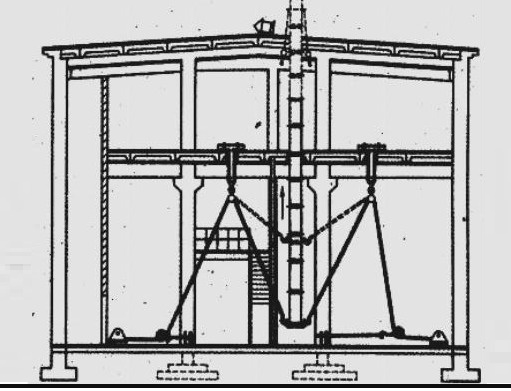
When assembling a vertical duct using the "squeezing" method, the existing threat of overturning the duct is eliminated with the help of braces. When lifting the structure, the lifting mechanisms operate at the same speed
With the help of two winches and blocks, the slings are pulled and the ventilation pipe is squeezed out 0.5 m above the roof. An umbrella is installed on the upper flange from the roof and the stretch marks are fixed. Then the air duct is lifted to the design level with winches, fixed with permanent fasteners, and the base plate and lifting rigging are removed.
Flexible air duct
Bendable pipes are often used in ventilation systems of apartments or private houses, offices, small retail premises.
The sequence of installation work:
- determination of the actual location of the channel with reference to the elevations of the building;
- installation of fasteners in the ceiling in the direction of laying the air duct, install dowels every 400 mm and hang clamps;
- stretching the flexible sleeve to the maximum and cutting into pieces of the desired length.
The soft sleeve is put on a rigid pipe with a minimum approach to its surface of 5 cm. Installation of flexible air ducts is carried out taking into account the direction of the moving air flows. They are oriented by marks on the pipe surface. The attachment points of such a channel are located at a distance of 1.5-3 m from each other. Sagging of the sleeves is allowed no more than 5 cm per 1 meter of total length.
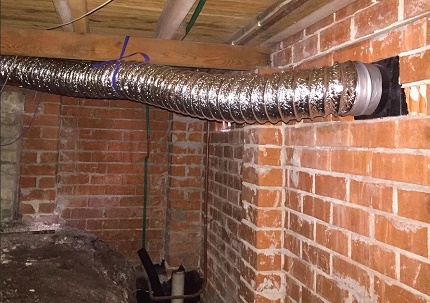
In order to exclude the formation of aerodynamic obstacles, flexible air ducts are laid with the least number of turns. They try to exclude the formation of bends both vertically and horizontally
If the flexible hose is laid behind a false ceiling parallel to its surface, the support clamps are placed at a distance of 100 mm. With vertical installation, the free space between the fasteners can increase up to 1800 mm. Flexible air ducts need protection from direct sunlight.
Elastic pipes have the ability to accumulate static voltage, it is important to ground the duct. For this, the grounding wire is fixed at one end on the metal frame of the sleeve.
Work safety
Most of the installation work is carried out at height. Hoisting gear required. It is obligatory to conduct a safety briefing for installers.
For a successful result of the stage of work at height, it is required that:
- The work was carried out only by trained, qualified installers.
- The work site was fenced, the passage of people near the object was limited.
- To reduce the risk of installation at height, all preparatory processes were carried out at zero.
When performing work in private houses, reliable strong scaffolds and inventory scaffolding are used. Work on laying ventilation pipes with thermal insulation is carried out in protective gloves and goggles.
The specifics of arranging the passage of ventilation pipes through the roofing pie will acquaint next article, which we advise you to read.
Conclusions and useful video on the topic
The process of assembly and installation of a ventilation system with fastening of air ducts to floor slabs is shown. The viewing speed and volume can be adjusted in the video settings. The installers use a hammer drill, fasteners, sealant, scaffolding, scaffolding.
The video material in two parts will acquaint you with the specifics of the duct network device:
Continued video tutorial:
Properly laid and fixed air ducts will provide an unimpeded supply of fresh air and the removal of waste mass from the treated premises. The ventilation ducts will not become clogged with dust deposits and cause inconvenience to the owners of the house or apartment. Execution of installation work in accordance with construction requirements will exclude violations and damage to the system.
Do you have any information on the topic of the article that is worth sharing with your site visitors? Do you want to supplement the information presented for consideration? Please write your comments in the form below, post a photo and ask questions on unclear and controversial points.


